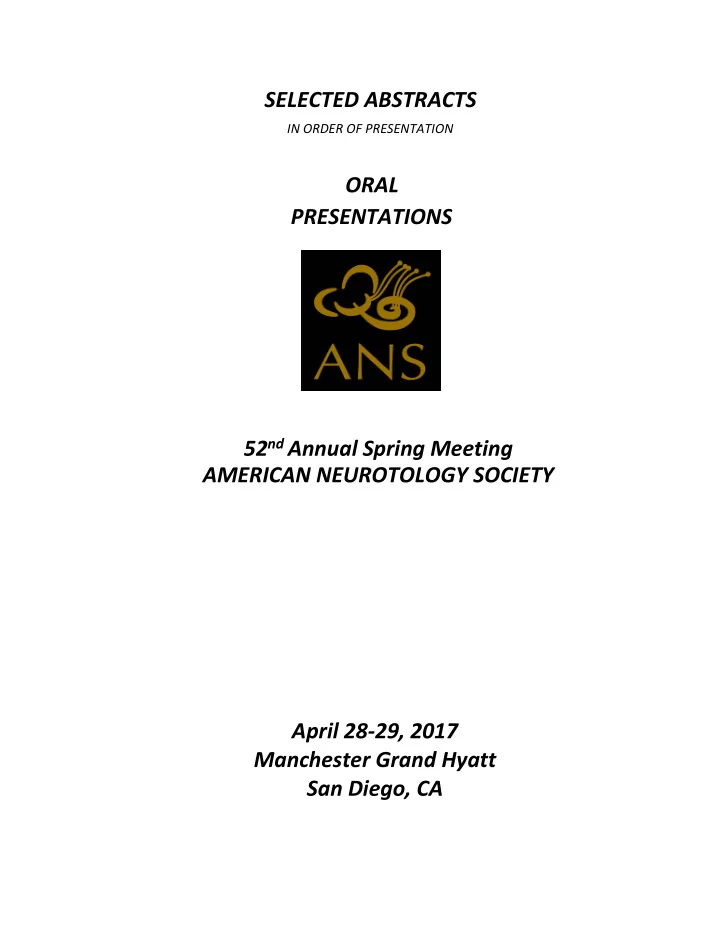

SELECTED ABSTRACTS IN ORDER OF PRESENTATION ORAL PRESENTATION S 5 2 nd Annual Spring Meeting AMERICAN NEUROTOLOGY SOCIETY April 28-29 , 201 7 Manchester Grand Hyatt San Diego, CA
Abnormal Cochleovestibular Nerves and Pediatric Hearing Outcomes: “Absent Cochlear Nerves” Can Derive Benefit from Cochlear Implantation Elina Kari, MD; John L. Go, MD Janice Loggins, AuD; Laurel Fisher, PhD Objective: Analyze imaging and hearing characteristics of children with cochleovestibular nerve (CVN) abnormalities and correlate these imaging characteristics with hearing and language outcomes after hearing aid fitting, cochlear implantation (CI) and/or auditory brainstem implantation (ABI). Study Design : Retrospective. Setting: Tertiary referral academic center. Patients: Twenty-eight children with CVN abnormalities with magnetic resonance (MRI) and/or computed tomography (CT). Intervention(s): none. Main Outcome Measure(s): Ability to determine presence or absence of a cochlear nerve, cochleovestibular abnormalities, and correlate imaging findings with response to auditory stimulation. Results: A total of 26 children with bilateral sensorineural hearing loss and abnormal CVNs and 2 children with unilateral findings (28 patients total) were evaluated (MRI/CT). There were equal numbers of males and females. Twelve children (39%) had comorbid conditions. Fifty-four (54) ears were identified with CVN abnormalities and analyzed. Fifteen (28%) ears were implanted with a CI and 8 (15%) with an ABI. The absence of a cochlear nerve was associated with an abnormal cochlear aperture, a narrow IAC and cochlear malformation. Thirteen (50%) ears with abnormal CVNs (n=26) exhibited normal cochlea. Hearing data were available on 23 anomalous ears. Eleven (49%) exhibited reproducible hearing thresholds either with or without a hearing aid, CI, or ABI. Some achieved open-set word recognition. Conclusions: Current imaging modalities cannot accurately characterize the functional status of the cochleovestibular nerve or predict a child’s benefit with either a CI or ABI. Several children who would have otherwise been denied a CI exhibited responses to auditory stimuli after implantation. Define Professional Practice Gap & Educational Need: Current imaging technology does not predict pediatric hearing outcomes and current literature typically describes "aplastic" or "absent" cochlear nerves. Our data show that despite this "absence", many children exhibit responses to sound and in some cases open set word recognition after hearing aids, CIs or ABIs. Our data highlight the need for novel imaging technologies and demonstrate that many of these children may achieve the same benefit from a CI than from an ABI. Learning Objective: To better understand the limits of MRI/CT in the evaluation of children with congenital SNHL and abnormal cochleovestibular nerves. To better appreciate that an absent cochlear nerve does not predict lack of auditory awareness or lack of benefit from a CI Desired Result: Attendees will consider CI for children with CVN abnormalities Attendees will understand the limitations of current imaging technologies and potentially revise their imaging protocols. Indicate IRB or IACUC Approval: Approved
An In-vitro Insertion-force Study of Magnetically Guided Lateral-wall, Cochlear-implant Electrodes Lisandro Leon, MS; Frank M. Warren, MD Jake J. Abbott, PhD Hypothesis: Insertion forces are reduced by magnetically guiding the tip of lateral-wall electrodes during insertion. Background: Steerable electrodes have the potential to minimize intracochlear trauma by reducing the contact between the electrode tip and the cochlear walls. We have experimented with lateral-wall electrodes with magnets at their tips. Magnetic torque can be applied to the tip so that it can be guided away from the medial wall through the cochlear hook and the lateral wall of the basal turn. To date, steerable electrodes have only been designed to curve in the direction of the basal turn. Methods: Automated insertions of electrodes with magnets are conducted into a scala-tympani phantom with a force sensor attached to it to provide the measurements needed to evaluate our hypothesis. An external magnet is used to apply magnetic bending torque to the magnetic electrode tip with the goal of directing the tip down the lumen. Experiments are conducted to mimic both cochleostomy and round-window insertions Results: T-test results indicate that magnetic guidance reduces insertion forces for all electrodes tested with certain electrode models achieving more than 50% reduction. For cochleostomy insertions, this benefit can be expected beyond 8 mm insertion depth while eliminating direct-tip contact with the lateral wall. For round- window insertions, direct-tip contact with the medial wall through the cochlear hook was also eliminated. Conclusions: Significant insertion force reduction can be obtained by applying magnetic guidance to the insertion of lateral-wall electrodes. This augments the superior flexibility of lateral-wall electrodes with a steerable mechanism. Define Professional Practice Gap & Educational Need: Clinicians are typically too busy or not connected with academic researchers to realize what the current state of the art is with engineered medical devices. Learning Objective: In this specific instance, a new technology is being developed to guide the insertion of a standard cochlear-implant electrode array with a robotic magnetic manipulator. Desired Result: Our goal is simply to educate the clinician of a possible robotic cochlear-implant insertion method that enables a lateral-wall electrode array to be navigated through the lumen using a non-stylet-based method. Indicate IRB or IACUC Approval: Approved
Recommend
More recommend